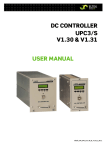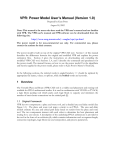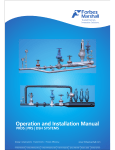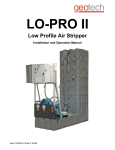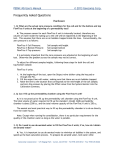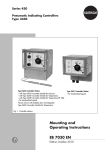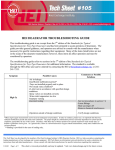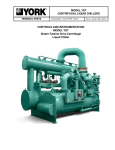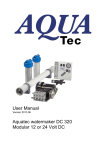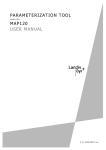Download here - Costec Systems
Transcript
NETALYSER rev.6/02.03 Costec Systems 1 NETALYSER A Process Utility Dynamic Analysis System The process analysis system NETALYSER is the in-house simulation system developed and used by Costec Systems for the dynamic analysis of power generation and process plant utility systems. It has been designed for the simulation of the transient behaviour of complex steam, gas and hydraulic networks and their associated peripheral systems such as steam and gas generators, gas holders, deaerators, tanks, etc. This document has been prepared for the information of clients of Costec Systems in order to acquaint them with the scope, methods, usage and utility of the NETALYSER system. It is not a User Manual. The system includes a user-configurable fully featured interactive GUI for the on-line control of the simulated plant. This can be displayed on one or up to four screens, depending on the selection of video graphics card. The basic system can be configured and used with no links to any external controls. However the system supports a TCP/IP interface link to an external SCADA or process control system. The process simulation configuration may therefore be separated from the user interface and plant controls, each which may be implemented on an external but coupled unit. Costec Systems Pty Ltd ENGINEERING CONSULTANTS 1 Avon St Cammeray NSW 2062 Australia Tel. (+61)(02) 9929 8885 Mobile (+61)(0)412 176 710 Fax (+61)(02) 9929 8885 Email [email protected] NETALYSER rev.6/02.03 Costec Systems 2 Contents 1 Overview 3 2 Preparation for a simulation study 4 3 NETALYSER Building Blocks 5 3.1 Networks . . . . . . . . . . . . . . . . . . . . . . . . . . . . . . . . . . . . . . . . 5 3.2 Aggregated components . . . . . . . . . . . . . . . . . . . . . . . . . . . . . . . . 6 3.3 Measurements . . . . . . . . . . . . . . . . . . . . . . . . . . . . . . . . . . . . . . 7 3.4 Selection of the working medium . . . . . . . . . . . . . . . . . . . . . . . . . . . 8 3.5 Treatment of compressibility of the working media . . . . . . . . . . . . . . . . . 8 3.6 Treatment of side flows . . . . . . . . . . . . . . . . . . . . . . . . . . . . . . . . . 8 3.7 Linkage of networks to aggregated components . . . . . . . . . . . . . . . . . . . 8 3.8 Fired and heat recovery evaporators . . . . . . . . . . . . . . . . . . . . . . . . . 9 4 The modelling approach 4.1 Simulation model organisation . . . . . . . . . . . . . . . . . . . . . . . . . . . . 11 11 5 Treatment of Controls 13 6 Graphical User Interface (GUI) 14 7 Display and Recording of Results 15 8 Simulation Control and Initialisation Facilities 16 9 Plant Data Requirements 17 10 Plant and Measurement Signal Naming Conventions 18 10.1 Plant Components . . . . . . . . . . . . . . . . . . . . . . . . . . . . . . . . . . . 18 10.2 Measurements . . . . . . . . . . . . . . . . . . . . . . . . . . . . . . . . . . . . . . 19 11 Project Management 20 12 Example of a Set of Working Documentation − A Process Energy Plant 20 NETALYSER 1 rev.6/02.03 Costec Systems 3 Overview Used for analysis of power plant and industrial process utility network transients NETALYSER is an advanced dynamic process simulation system used to quantify answers to questions of transient behaviour arising in the course of the design and operation of large power stations, industrial process gas or steam systems, waste heat recovery or of hydraulic networks handling such things as condensate recovery, water-treatment reticulation, fuel-oil distribution, heat exchanger networks or tank farms. Analysis of “what if” situations NETALYSER is ideally suited to the systematic analysis of “what-if” situations which can arise as a consequence of equipment malfunction, altered operating procedures, plant or control system modifications or unexpected or unintended external influences. Detailed analysis of transient events can be undertaken with high dynamic accuracy. The steady-state conditions achieved at the conclusion of the transient will accurately reflect mass and energy balances throughout the plant. Stand-alone Windows application NETALYSER is configured to operate on a standard high performance PC (Windows 9x, NT4.0, 2000, XP). It is built around a purpose-designed high-speed computation “engine” . By providing easy-to-use facilities for initialisation, computation, data and graphical display and documentation, NETALYSER allows the user to focus on simulation and problem-solving without the need for extensive technical computing experience, all within a user-friendly Windows environment. Use of database tables for data entry and problem configuration To reduce the time spent on problem preparation and the risk of errors during the definition and configuration phases, NETALYSER eliminates the need for original code preparation. Configuration tables define the principal elements of the system under investigation. The system supports several standard database packages such as Inprise (Borland) Paradox and Microsoft Access, ensuring compatibility with a wide user-base. Clients can prepare their own plant databases on their own sites using pre-defined tables for direct input to the analysis system. A sophisticated configuration utility converts the configuration table information into a set of internal tables used by the system to set up all requisite simulation model interconnections and database linkages. The configuration utility performs extensive validity checking to ensure that the user has complied with the NETALYSER rules. Errors are notified to the user via an error log and must be corrected before the simulation can be executed. NETALYSER 2 rev.6/02.03 Costec Systems 4 Preparation for a simulation study The simulation study of a power generation or process plant using the NETALYSER system is preceded by the following: • inspection and analysis of the plant, leading to the production of system topology and interconnection diagrams, annotated according to NETALYSER naming conventions • collection and collation of the individual items of data for each plant component • list and naming of measurements and their connection points • automatic control loop functional diagrams • design of a graphical user interface (GUI) and its linkage to the plant. A database table of pre-defined format is used to present each of these items to the NETALYSER computation engine. The bulk of the simulation is therefore configured by the user by the completion of a set of database tables, with no writing of computer code. High-speed computation engine is the core of the system The core of the NETALYSER system is its high-speed computation engine. Specifically developed for this application, it is an advanced algorithm which automatically builds and then solves the network system matrix equations which describe the complex time-varying and spatially distributed behaviour of the complete network. Unlike other simulation methods which build up a complex system by the user’s interconnection of discrete plant components, NETALYSER builds a set of matrix equations directly from the network topology information and plant data set up by the user. Spatially-distributed effects (one-dimensional, in the direction of flow) are included by the representation of each network element as a contiguous set of control volumes or cells. Two coupled matrix equations are formed, one solving for the pressure/flow distribution and one for the enthalpy/temperature distribution simultaneously at all points (cells) throughout the network. The coefficients of the two matrix equations and each interfacing component are computed directly from the user-entered plant data, using sound physically-based models, supported by well-established and documented engineering correlations for pressure loss and heat transfer coefficients, together with routines for the computation of the (single component) transport and thermodynamic properties of the working media. Each coefficient is computed as the product of two elements, − one which is a function only of the physical design and materials of the plant and is computed once during initialisation of the problem, and − one which is recomputed each computation cycle and includes the non-linear process state and thermodynamic dependencies of the equation coefficients. The interfacing - and in the case of multiple networks, interconnecting - components and controls are computed on a component-by-component basis. NETALYSER 3 rev.6/02.03 NETALYSER Costec Systems 5 Building Blocks NETALYSER offers a wide set of standard building block components from which process plant simulations can be assembled. Process plant utility sub-systems are formed as the interconnection of • one or several piping or duct networks • a number of aggregated (lumped) plant components to which some network branches connect • a set of measurements derived from sensors within the network and aggregated components • a set of regulating control loops with associated protection, interlocking and selection logic. 3.1 Networks Networks are spatially distributed, sometimes over considerable distances. Their dynamic simulation must be capable of reproducing the relevant consequences of this spatial extension. Components are generally not spatially distributed although, in some cases, the accurate reproduction of their internal processes needs spatial effects to be considered. Networks are ephemeral and come into existence only as required by a specific application. There are no libraries of networks. Typically, networks are built up as the interconnection of simple components into branches. Individual networks are joined together by connection to complex components at their external nodes or interfacing points. The aggregated components are frequently elements featuring significant mass or energy storage. As such they serve as stable sources of boundary conditions for the more fragile networks which typically feature small volumes, coupled non-linearities and rapid transients, the right ingredients for numerical stability problems. Most process plant sub-systems can be considered as networks for simulation purposes. Systems which lend themselves to treatment as networks are summarised in the following list. • Hydraulic systems • • • • • • Feedwater Condensate recirculation Bearing lubrication Power oil circuits Condenser cooling water Miscellaneous cooling water systems • Air and gas systems • • • • Compressed air Furnace combustion air (primary, secondary and tertiary) Flue and exhaust gas Air extraction and vacuum systems • Steam systems • • • • High, intermediate and low pressure steam distributiion Auxiliary steam generation and distribution Gland sealing Steam line tracing NETALYSER rev.6/02.03 Costec Systems 6 Network branches are formed as the serial interconnection of one or more components, drawn from the following: • Steam systems • • • • • • circular pipe valve (located in a circular pipe) expansion turbine (condensing or back-pressure) thermo-compressor tubular heat exchanger, steam/gas tubular heat exchanger, steam/fluid • Gas systems • • • • • • • • • circular pipe (pressurised system) rectangular duct (near-atmospheric system) fan (axial/centrifugal) control valve (circular pipe) control damper (louvres, in rectangular ducts) tubular heat exchanger, gas/steam tubular heat exchanger, gas/gas tubular heat exchanger, gas/fluid gas turbine • Hydraulic systems • • • • • • • 3.2 circular pipe valve centrifugal pump fin-fan cooler shell/tube heat exchanger, fluid/fluid tubular heat exchanger, fluid/gas tubular heat exchanger, fluid/steam Aggregated components Aggregated components are complex, stand-alone equipment to which the networks connect and which serve to define the external boundary conditions of those networks. They include: Water/steam systems • • • • • • drum boiler (dual fuel firing) (with/without integrated superheater) waste heat recovery boiler direct-contact heater/evaporator deaerator water-cooled condenser gas turbine Gas systems • fixed volumetric flow source • gas holder • gas burner or burner register General • atmosphere • tank - cylindrical/vertical/horizontal/open/enclosed This selection of components and devices is adequate for most applications. New elements (e.g., fluidized-bed, once-through and fuming furnaces, evaporators) may be added to suit specific requirements. NETALYSER 3.3 rev.6/02.03 Costec Systems 7 Measurements Measurements available for connection to any network cell (see section 4.2) or peripheral components include but are not limited to: Network nents compo- • • • • pressure of the working medium temperature of the working medium mass or volumetric flow of the working medium inner and outer temperatures of the metal containing wall. steam and gas turbines • generated electric power (MW) • gas turbine exhaust and other air/gas temperatures • selected metal temperatures drum boilers • • • • • • • waste heat recovery boiler • as for a drum boiler tanks • • • • • deaerator • as for a tank gas holder • gas volume • rate of change of gas volume. drum water level individual downcomer and riser metal temperatures drum water enthalpy and temperature drum pressure drum saturation (steam) temperature riser heat absorption and heat distribution upper and lower drum metal temperatures fluid level temperature of fluid and gas pressure in the gas/vapour space pressure at the lower connection stub (level-dependent) heat transfer to/from tubes (immersion heating) All measurements except temperature are provided without measurement lag. Lags in temperature measurements Two forms of thermal lag are provided for temperature measurements. The first is a simple first-order lag with adjustable lag time constant and is typically used for low-pressure applications and direct measurement of metal temperatures. Thermocouple pocket dynamics If the thermal dynamics of the thermocouple pocket are felt to be significant, a special thermocouple pocket model may be interposed between the raw process variable and the measurement. This represents the thermocouple pocket as a three-stage heat transfer path involving heat exchanges between the working fluid, pocket metal and pipe wall. It reproduces the physical pressure and flow dependent measurement errors and delays. NETALYSER 3.4 Each branch has its own working medium rev.6/02.03 Costec Systems 8 Selection of the working medium A working medium must be assigned to each branch of a network. Available media (shown with the configuration code) include (at this time): • • • • • • • water/steam (ws) air (ar) flue gas (fg) natural gas (ng) lubricating oil (lb) light fuel oil (lo) heavy fuel oil (ho) This permits, for example, the user to configure heat exchangers as links between branches having differing medium properties. For example, the primary side of a superheater bank can be in a water/steam branch with its secondary side in a flue gas branch. 3.5 Compressibility of the working medium in each branch Treatment of compressibility of the working media By setting a compressibility flag for each branch the user can direct the computation engine to treat the working medium as compressible or incompressible. Branches carrying steam, for example, would normally be treated as compressible whereas branches carrying water and oil, such as found in cooling and lubricating oil circuits, would be treated as incompressible. A water/steam branch in which phase change is known or expected would always be treated as compressible. Choice of compressibility effects only the method of calculation of pressures and flows. The calculation of thermal effects and heat transfer is independent of compressibility assumptions with the exception that compression energy is ignored in an incompressible branch. 3.6 Treatment of side flows The usual and recommended method for joining flow paths within a network is via an internal node at the point of intersection. However, in some cases such as leak flows, it can be more convenient to introduce a “side flow”. NETALYSER allows the connection of a flow path to one cell along a network branch. The flow path can include a valve or damper and might be used to connect, say, a drain valve or steam trap to a pipe. The selection of the connecting cell will usually reflect the physical location of the leak or drain along the branch and may be within another component, such as a heat exchanger. The user is required to specify the index of the cell to which the side flow connects and the thermodynamic conditions at the “other” end. Alternatively, the “other end” can be connected to a specific connection stub on an aggregated component (such as a tank), to a specific node in a network or to atmosphere. 3.7 Linkage of networks to aggregated components Network branches connect to peripheral aggregated components at pre-defined connection stubs. A stub is associated with a unique index which identifies the specific point of contact to the component. Any number of branches can connect to a given stub. The various stubs and their associated indices are summarised by the following table. NETALYSER rev.6/02.03 Component Tank Drum Condenser Feedwater heater Deaerator Furnace Burner 3.8 Lumped and distributed evaporator models Costec Systems Stub Index 1 2 1 2 3 4 1 2 3 1 2 3 4 1 2 3 4 5 6 7 8 1 2 3 4 5 6 i j 9 Connects to gas space liquid space outgoing steam line feedwater inflow drum water drum steam space steam space hotwell air extraction bled steam drain outflow cascade drain inflow shell steam space bled steam support steam condensate inflow cascade drain 1 inflow cascade drain 2 inflow common drain outflow feedwater outflow water space gas recirculation secondary air supplementary air flue gas fuel oil fuel gas furnace index burner/mill/primary air index Fired and heat recovery evaporators The dynamic behaviour of the evaporator is frequently a dominant influence on the start-up and manoeuvring dynamics of power and steam generating plant. This can apply to both fired and heat recovery boilers. For some cases, for which the principal interest is in the behaviour of the steam system itself, a simple generic boiler module can provide simulation of sufficient accuracy. This module is an implementation of the model described by Åstrom and Bell 1 . For applications requiring more detailed information on the behaviour of the boiler plant itself, such as those looking at the dynamic interactions between fuel supply, furnace heat release and distribution, steam generation rates and steam pressure and temperature controls, a more detailed module is available. This is a 10-cell one-dimensional (in the direction of flow) distributed model of the evaporator which may be configured either as a loop consisting of interconnected modules for the drum, hydraulic circuit (downcomer pipes, assisted circulation pumps, header drains) and two-phase riser, or as a Benson once-through boiler configuration. Flow conditions in the hydraulic sections of the loop are treated as incompressible and homogeneous. Note that this does not preclude the treatment of steam entrainment from the drum into the downcomer, a condition which creates a small steam phase at the riser inlet. The state of the working fluid in the riser can change from water only (zero steam fraction, prior to commencement of boiling) up to a maximum steam mass quality of 0.7 (limit of validity of two-phase 1 Simple Drum Boiler Models IFAC Symposium on Power Systems, Modeling and Control Applications, Brussels, 5-8 September 1988 NETALYSER rev.6/02.03 Costec Systems 10 pressure drop and heat transfer correlations). Phase slip in the riser can be treated but zero slip conditions are normally assumed. In the Benson boiler configuration the increase of steam mass fraction above 0.7 is accommodated by transition to “burn-out” heat transfer and pressure drop correlations. Associated furnace heat release and distribution model An associated linked furnace module provides point-model computation of total heat release and lumped heat distribution within the furnace cavity and radiative transfer to absorbing surfaces visible beyond the cavity. Using a centre-of-flame concept, parametized empirical heat distribution profiling functions are available to distribute the heat transfer axially along the waterwalls. This profile is used by the riser module as the source of heat input to the tubes. The user may set the profiling function to suit expectations or measurements of heat distribution and link the profiling parameters to other conditions of the furnace such as burner configuration and tilts. NETALYSER 4 4.1 rev.6/02.03 Costec Systems 11 The modelling approach Simulation model organisation The majority of process systems can be best represented mathematically by some differential/algebraic equation system. The describing equations will establish the causal relationships which exist physically among two sets of quantities, inputs and outputs, via a third set, the internal “states” of the process. The physical data about the process and its environment used by the model is encapsulated within a fourth set of quantities which we will notate simply as “data”. These relationships are illustrated by the following diagram: [Inputs] =⇒ [States] =⇒ [Outputs] ⇑ [Data] States: These are quantities whose values completely define the state of the process at any time. Multiple states are grouped together into a state vector or array. The time evolution of a process is described by the time evolution of its states. In the usual representation of process mathematical modeling each state is associated with a single differential or difference equation through which its rate of change with respect to time and/or one or more spatial variables is related to itself and other states and to the process inputs. The simulation model generates the time and spatial evolution of the states moving in response to the changing inputs. Outputs: In conventional process control terms, outputs are those quantities which can be measured or estimated. They are usually produced by the plant instrumentation and are used for control, operator information and general data processing purposes. In simulation terms, in which only models exist, outputs are quantities derived from states and inputs. They are used to link models by providing the inputs needed by other models, downstream in the execution sequence. They may be sent to peripheral processing systems such as the plant data processing computer. Outputs are related to their source variables via algebraic equations or decision variables. They do not have internal states of their own. Inputs: Again, in conventional process control terms, process inputs are either actuation commands given to the positioning actuators of the various control devices of the plant (valves, pumps, dampers, etc.), or are the defining parameters of material and other flows entering the process. In simulation terms the outputs and inputs define the set of matching quantities via which individual models communicate with each other or which define the boundary conditions of the process. In most cases, but not always, one model’s output array provides elements of the input arrays of one or more other models. NETALYSER rev.6/02.03 Costec Systems 12 Data encompasses the numerical values of all of the coefficients of the equations the model will use. It usually comes in two flavours: (i) static data, which, once calculated, does not change as the process evolves, and (ii) dynamic data, which is recalculated and updated either every computation cycle or periodically as conditions elsewhere within the simulation change. Static data is largely derived from the physical design parameters of the plant (sizes, geometries, fixed characteristics, environmental parameters, etc.). Dynamic data is largely derived from changing process conditions such as the physical properties of materials and of the working media, composition of the working media, heat exchange coefficients and friction factors which depend on thermodynamic and flow states, tank levels which depend on tank geometries, pump head/flow relationships which depend on speed, etc. These dynamically varying properties and parameters are the usual sources of (sometimes extreme) process non-linearities. Material properties are computed for all working media as functions of current thermodynamic conditions. Accuracy is assured by the use of table lookups combined with efficient interpolation schemes supplemented where appropriate by high-fidelity polynomial fitting functions. NETALYSER 5 Standard actuator interface rev.6/02.03 Costec Systems 13 Treatment of Controls NETALYSER provides a standard interface to all actuators and motorized drives (pumps, fans) for modulating controls and manual GUI control stations. The figure shows the standard arrangement for a control valve. Valve Position Manual Actual 0 100 0 − 100% Trip Setpoint 6 + ? index - ? rate- h - h - + − ? + 6 meas value Setpoint (fixed) CL - 3-Term Controller CL- OP CONTROLS − Logic Setpoint Follower GUI OP ? ? Switch Gear Logic CL - OP 666 Direction 666 auto Parameters index manu local Actuator 6 runtime - Valve Stem Position This arrangement includes connections and assignments for single input/single output modulating controller loops. The loop includes a standard discrete-step 3-term (proportional-integralderivative) controller whose tuning parameters are to be adjusted by the user. Three operating locations are available for any actuator or motorized drive: Local : Remote : manual operation only; drive position set directly from GUI or in response to interlock signals manual operation of a drive which is not the final control element of a modulating control loop; no controller action manual operation of a drive which is the final control element of a modulating control loop;controller action blocked when in manual mode; auto/manual selector in the associated GUI module : Three operating modes are available for any actuator: Stepping Latched : : Trip : The actuator moves a single step for each manual pushbutton operation. The actuator moves continuously in the selected direction until stopped by the operator or it reaches the fully open or fully closed position. The actuator closes at high speed; reopening of the actuator requires manual clearance of the trip signal. An actuator selector to automatic mode cannot be latched. A trip command will override automatic or manual commands. Configuration control loops of The user can configure any standard drive interface and its associated control loop interactively by appropriate entries in the database configuration table. The configuration of more complex control loops, involving the formation of the controlled variable from multiple measurements, multiple interactive or cascaded control loops or overriding or integrated logic, will require the preparation of special code using the standard NETALYSER control block library. Alternatively, these controls may be prepared graphically using some other controls design package and linked to the standard NETALYSER framework via the TCP/IP link. NETALYSER 6 rev.6/02.03 Costec Systems 14 Graphical User Interface (GUI) Process monitoring and manual control The Graphical User Interface is used for control of the process during the computation sequence. The user is able to intervene at any time during the course of the event under study as if controlling the real plant (though clearly not via the same displays and facilities which might be found in the real plant). The user is guided in the choice of intervention by the time-based trend and digital information displayed on the screen and can immediately observe the result of such intervention. Configuration the GUI NETALYSER provides facilities for the configuration of a useful GUI. The NETALYSER system includes a GUI builder for the configuration and integration of a single GUI window, formed from a standard set of GUI building blocks. The GUI is formed as a tiled mosaic of control and data display modules, organized into a pre-sized arrangement of rows and columns. The GUI is configured by entry of display module screen coordinates and display texts in the configuration tables for measurements, actuators and controls. of GUI functions Functions implemented via the GUI include • • • • • • • • • GUI module displays adjustment of a fixed setpoint adjustment of a valve/damper position motor start/stop/trip valve/damper trip closed status change toggle on/off or open/close of any discrete state device selection of one of a set of alternatives digital status display numeric measurement value display trend graph display All displays are labelled with a user-defined text. Each GUI module displays process information relevant to the device: • for a valve or damper ◦ mass flow through the device ◦ differential pressure across the device ◦ stem or shaft position • for a motor drive ◦ mass flow through the device ◦ differential pressure across the device ◦ speed (in rpm) For a controlled valve or damper the GUI module is labelled with the signal code name of the controlled measurement. The GUI module displays • the numeric value of the controlled measurement • the deviation from setpoint (+/-) • the position (%) of the controlled actuator. NETALYSER 7 rev.6/02.03 Costec Systems 15 Display and Recording of Results Facilities for the display and recording of computation results have been integrated into the NETALYSER system to provide for • the on-line display of computed values in numeric format with appropriate descriptive labels and units, • the display of trend graphs which show the evolution with time of selected computed variables, • labelled summary graphs covering the complete duration of the computation interval. The first two displays provide information to the user on the evolution of the event and can be used to guide manual operational intervention. The third is used for off-line hard-copy documentation of the investigation results for later scrutiny and inclusion in reports. All displays are in colour. A variety of devices are available for the GUI display of measured variables. These include labelled numeric display windows and a number of traditional linear and rotary meters. A selection of these is shown below. These indicators also have the capability to alarm limit violations via a flashing display. The system includes a background recording facility for the automatic recording of a log of all configured measurements. Each measurement is sampled at a default rate of two seconds and stored to disk at regular intervals (5 minutes) in a text file format suitable for the off-line production of high quality charts. NETALYSER 8 rev.6/02.03 Costec Systems 16 Simulation Control and Initialisation Facilities A computation procedure designed to yield information on a steady-state condition results in the production of a single (perhaps large) set of data. A procedure designed to yield information on dynamic transient behaviour will result in a series of (perhaps large) sets of data which define the future evolution of a set of process variables. Successive data sets are separated in time by the discrete time step, selected by the user to match the expected transient characteristics of the process under study. For process plant this is typically in the range 0.25 to 5 seconds though accurate reproduction of control system behaviour during fast transients will usually impose an upper limit of 1 second. Selection of discrete time step The NETALYSER system utilises a number of internal timers for computation and display sequencing. Internal computations are executed with a user-selectable fixed time duration. Its default value of 50 milliseconds ensures a high degree of dynamic accuracy, even for fast transients. GUI displays are updated every second. FREEZE/RUN selection The user may toggle the computation sequence between its RUN and FREEZE modes. In RUN mode the computation will continue to iterate indefinitely. In FREEZE mode the computation sequence is suspended and will be resumed upon reselection of RUN mode. The user can cause the execution of a single step (STEP mode) of the computation sequence for step-by-step examination of the evolution of the event under study. SAVE and LOAD functions The state of the simulation computation (that is, the values of all State and Input variables) may be saved for later use as an initialisation state. The NETALYSER system provides an Initial Condition management facility for the storage and subsequent recovery of an initialisation state. It is the user’s responsibility to assign meaningful names to and to back-up these files. Any file so saved can be used as the initial state for subsequent analysis. NETALYSER 9 Physically-based models need extensive plant data rev.6/02.03 Costec Systems 17 Plant Data Requirements The process models used by NETALYSER are derived by the systematic application of mass, energy and momentum balances and by the use of established engineering formulae for pressure loss and heat transfer coefficients. With the exception of a small number of empirical constants introduced to account for imponderables in the characterisation of process plant, all model coefficients are expressed in terms of basic plant arrangement and physical design data. While this approach yields high accuracy and reliability of the computation results and makes possible the prediction of plant behaviour on the basis of design information only, it creates the need for the identification and entry of considerable basic plant data. This is less onerous than may at first appear, as much of the plant data relates to material properties and arrangement factors for which standard Handbook figures can be used and which will be approximately the same for all like components in a given plant. The completion of plant data tables can therefore be greatly accelerated by the judicious use of the table editing facilities. Relative importance of some elements of plant data Not all data items are equally important, and their accuracy can be matched to the principal results expected from individual investigations. For example, if the principal interest is pressure/flow behaviour, the extensive data relating to enthalpy/temperature distribution may be estimated and sensitivity checks made to demonstrate the absence of any adverse effect on pressure behaviour which may arise because of the coupling between the two equation systems. The reverse will not apply as accurate prediction of enthalpy/temperature behaviour will presuppose accurate prediction of pressure/flow behaviour. Example: tubular heat exchanger An indication of detailed data requirements is given by the following comprehensive list of data for a tubular heat exchanger enclosed in a gas duct. dde dwi dL rinsul f hx cm lam rhom tdi tdo geo thyr ntpb ntbd ntr tf e tf z tL duct section depth duct section width duct section length thickness of duct insulation tube outer surface fouling factor tube metal specific heat tube metal thermal conductivity coefficient tube metal density tube inner diameter tube outer diameter reference geodetic height of the heat exchanger above site datum inner tube surface hydraulic roughness number of tubes per tube bundle number of tube bundles per row number of tube rows tube bank arrangement factor tube row count correction factor for ntr > 10 mean tube length NETALYSER 10 rev.6/02.03 Costec Systems 18 Plant and Measurement Signal Naming Conventions The configuration tools available to the user with the NETALYSER system rely on the use of strictly defined component and signal naming conventions. Only by the user’s careful adherence to these conventions can the configuration utilities identify the type and specific index of the component to be linked, or the raw computed variable to which a measurement will be linked. 10.1 Component codes used in plant configuration tables Plant Components Every plant component used within a network or as an interface to a network is identified by a five-character code with the standard format abcnm where − abc is a 3-character alphabetic device type code − nm is a numeric index in the range 01-99. The full list of device type codes is given in the User’s Reference Manual. Some samples are vlv dpr pip pmp cpr trb trg hxc tux tug duc blr hrb cdn tcp : : : : : : : : : : : : : : : valve gas damper pipe pump thermo-compressor expansion steam turbine gas turbine shell/tube heat exchanger tubular heat exchanger, steam/gas tubular heat exchanger, gas/gas gas duct fired boiler heat recovery boiler water-cooled steam condenser thermocouple pocket The entry of pip42, for example, into a network configuration table indicates to the configuration builder that the indicated position in the network branch is a pipe, and that the data to be used in building the network matrix equations is that listed for the 42nd element in the pipe database. Typographical case convention for component codes With the exception of some heat exchangers, all device codes are entered into the configuration tables in lower case. For heat exchangers with both a primary and secondary side, the secondary side assignment is indicated by the use of upper-case. NETALYSER 10.2 Signal codes used to link measurements to sources and users rev.6/02.03 Costec Systems 19 Measurements In order to be available for GUI display or as an input to a control system, a raw computed variable must be assigned and thereby linked to a measurement name. This name is used by the system to create the link between the source variable and the internal user. A measurement name is a lower-case 11-character string, ‘aa nn aa nn a nn’, where ‘a’ and ‘n’ indicate an alphabetic and numeric character, respectively. There are two schemes for decoding the name string, one for measurements sourced from networks and the other for measurements sourced from non-network components. Each of these coding conventions is illustrated by the following examples. Measurement naming conventions Measurements sourced from networks nt01br09f03 nt02br27p02 nt01nd06t00 nt03br16i03 nt01br16q07 : : : : : flow (f) in cell 3 of branch (br) 09 of network 1 pressure (p) in cell 2 of branch 27 of network 2 temperature (t) in node (nd) 06 of network 1 inner metal temperature (i) of cell 3 of branch 16 of network 3 inner wall heat transfer (q) of cell 7 of branch 16 of network 1 Measurements sourced from aggregated components Each component simulation model is written as a library procedure and returns the state and output vectors to the calling program. The contents and ordering of each vector are set out for each component in the User’s Reference Manual. A measurement may be connected to any element of either of these vectors by encoding its reference as illustrated by the following examples. The use of ‘x’ in position 5 indicates the source is not a network component. The next character indicates whether the source is a state [‘s’] or output [‘y’] model variable. The first two characters identify the component type and the numeric index after the [‘xs’] or [‘xy’] identify the specific component. Finally the last three characters identify the specific variable or measurement. These are illustrated by the following examples. dr03xs05t01 rs02xs06t05 da03xy04p01 fh03xs01p01 tk14xs01o03 st39xy00W01 : : : : : : upper metal temperature (state 5) of drum (dr) 3 fluid temperature (state 6) of the 5th cell (of 10) of the riser of boiler 2 pressure at the bottom takeoff point (output 4) of deaerator (da) 3 body pressure (state 1) of feedwater heater (fh) 3 pressure in the gas space (state 1) of tank (tk) 14. total power (kW) developed in steam turbines 3 to 9. This coding system gives the user access to every state and output variable within the scope of simulation, regardless of how many. The measurement database is constructed as a simple database table as part of the simulation configuration. This database includes specification of GUI display location and trend recording assignments, scaling and offset of displayed variables, and other information. NETALYSER 11 rev.6/02.03 Costec Systems 20 Project Management It is assumed that, in an engineering office environment, more than one project will be under investigation or development at any one time. NETALYSER provides facilities for the definition and management of several simulation projects on the one PC. The system will automatically create and group into project-specific directories all data files, tables, ICs and measurement logs created for a project. The system maintains a project name list from which the user can select a target project to work on. 12 Example of a Set of Working Documentation − A Process Energy Plant The following schematic diagrams show the extensive scope of simulation for an energy plant typical of the chemical process and mining industries. The plant consists of 3 x 50 T/hr plus 1 x 100 T/Hr gas-fired boilers, 2 x 8 MW steam turbine driven electric generators and miscellaneous other plant, including an additional 2 steam turbines driving blowers/air compressors. The HP steam pressure system is supplied by the fired boilers with pressure regulation via the gas flow rate control. The LP system is supplied by the turbine exhausts and is regulated via two letdown valves from the HP system. The 3 smaller boilers share a common steam turbine driven feedpump with individual drum level regulation via independent feed regulating valves. The 4th boiler has an independent turbine driven feedpump and drum level regulation. The system physically extends over a large site with some steam distribution pipes up to 1 km in length. The NETALYSER simulation dynamically computes the thermodynamic and flow properties of the working medium (steam, water, air, gas) in 128 cells throughout the connected flow networks. It also dynamically computes the thermodynamic, flow and mass properties of the working media within each of the lumped components(furnaces, boiler evaporators and drums, deaerator, condensers, etc) and the work done by the individual rotating components (steam turbines, compressors and pumps). The entire system is recalculated in real time each 50 milliseconds as the dynamic events evolve. Also shown are a screen print of the user-configured interactive GUI used to control this plant during simulation testing and a sample print of simulation computation results in the form of summary trend graphs, showing the response of the steam system to the loss of one heavily loaded boiler, followed by a combination of manual and automated response measures. NETALYSER rev.6/02.03 Process Plant − Main Steam System Schematic Costec Systems 21 NETALYSER rev.6/02.03 Process Plant − Feedwater Supply System with Economisers Costec Systems 22 NETALYSER rev.6/02.03 Costec Systems Process Plant − Fuel Gas, Combustion Air and Flue Gas System Schematic 23 NETALYSER rev.6/02.03 Costec Systems Process Plant − User-Configured Control GUI with Real-Time Trending 24 NETALYSER rev.6/02.03 Costec Systems Process Plant − Simulated Trip of One of Four Boilers with Recovery Measures 25

























